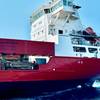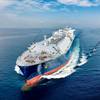According to the Coast Guard, the Marine Spill Response Corporation (MSRC) oil recovery vessel VIRGINIA RESPONDER began skimming operations, however, recoverable oil is widely dispersed and the amount recovered has been minimal to date. A helicopter has been flying throughout the day to locate patches of oil and direct the skimming vessel. The oil spill recovery vessel has been on-scene since Monday prepared to recover oil.
Previous flights of the area located oil that was too spotty, patchy and widely dispersed to efficiently pick-up. On-scene conditions are favorable.
During a Tuesday over flight, patches of oil were located in the area where the T/V BOW MARINER sank Saturday night.
Yesterday the Norfolk, Va., based NOAA Ship RUDE swept the area where the T/V BOW MARINER sank with side scan sonar technology to acquire imagery of the vessel. The RUDE will conduct additional sweeps on Thursday to obtain additional imagery of the wreck. It is anticipated that underwater imagery will prove useful in assessing potential recovery of fuel and cargo.
RUDE was previously tasked with side scan sonar imaging duties during the search and recovery of TWA flight 800 in 1996 and the search and recovery operations of John F. Kennedy Jr's aircraft and Egypt Air flight 990 off the Massachusetts coast in 1999.
The T/V BOW MARINER, a Singapore-flagged chemical tanker, left Linden, N.J., for Texas City, Texas, carrying a partial cargo of 3.2 million gallons ethanol when it exploded and sank 50 miles off the Virginia coast Saturday night. The Coast Guard rescued six crewmembers, three deceased crewmembers were recovered and 18 crewmen are still missing.
Floating debris from the wreck is still in the area, mariners should maintain a sharp lookout when transiting the area. Clean Harbors has been contracted to recover floating debris to reduce any hazards to navigation. Ethanol released in the accident has dissipated. Oil in the slicks could pose an irritation hazard if it comes in contact with the skin, otherwise it does not appear to be a health concern to people or fisheries at this time.
Operations to secure the source of leaking oil and remove it from the wreck are being monitored by the U.S. Coast Guard Marine Safety Office in Norfolk, Va., and an inter-agency Unified Command which includes the Coast Guard Captain of the Port, National Oceanic and Atmospheric Administration, Virginia Dept. of Environmental Quality, Maryland Dept. of Environment, and representatives from the vessel owners and managers.
Subscribe for
Maritime Reporter E-News
Maritime Reporter E-News is the maritime industry's largest circulation and most authoritative ENews Service, delivered to your Email five times per week










